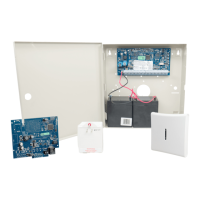
Do you have a question about the DSC neo HS2016 and is the answer not in the manual?
| Partitions | 2 |
|---|---|
| Type | Hybrid |
| Input Voltage | 16.5 VAC |
| Weight | 3.5 lbs |
| PGMs | 2 |
| Hardwired Zones | 6 on-board, expandable |
Overview of system components, keypad types, and zone protection.
Information on monitoring carbon monoxide detectors and required warnings.
Details on monitoring fire detection devices and proper installation.
Instructions for performing weekly system tests and important notes.
Capabilities of transmitting alarms, troubles, and emergency information.
Guidelines for keeping the security system in optimal condition.
Explanation of symbols and LEDs used on different keypad models.
List and descriptions of available PowerSeries Neo keypad models.
Methods for setting or arming the alarm system using keypad or wireless key.
How to partially activate the alarm system for home occupancy.
Arming the system with limited interior movement allowance.
Arming the system in Stay mode without entry delay.
Using Quick Exit to leave while armed without disarming.
Using wireless keys to arm the system.
How to intentionally unprotect specific zones before arming.
Programming frequently bypassed zones into groups for easier use.
Notifications for improper arming attempts or exit faults.
Methods to disarm or unset the alarm system.
Using a proximity tag to disarm the system.
Handling invalid access codes during disarming.
Types of alarm sounds and their meanings.
Procedure to reset smoke detectors after an alarm.
How to use wireless keys for arming/disarming and other functions.
Utilizing proximity tags for system access and functions.
Controlling the system remotely via text messages.
Different types of user access codes and their capabilities.
Procedures for managing user access codes.
Procedures for associating proximity tags with users.
Restricting user access to specific partitions.
Setting extra options like supervisor codes or zone bypass.
Viewing a list of the last 1000 system events.
How to configure the system's current time and date.
Managing automatic arming/disarming schedules.
Configuring specific times for automatic system arming.
Verifying system detector operation and notifying the central station.
Identifying and understanding system trouble indicators and codes.
Dividing the system into independent areas for security.
How fire and CO zones function within partitions.
Enabling or disabling audible door chime notifications.
Allowing two-way audio sessions for alarm verification.
Using video clips for alarm verification.
Controlling external devices like garage doors via system outputs.
Features for confirmed alarms and immediate police response.
Verifying fire alarms to ensure proper response.
Guidelines for cleaning and maintaining the alarm controller.
Recommendations for the placement of smoke detectors.
Developing and rehearsing family escape plans.
Guidance on locating and installing CO detectors.
Section to record system details like exit/entry delay times.
Place to record central station and installer contact details.
Reference sheet for user codes and sensor/zone mapping.
